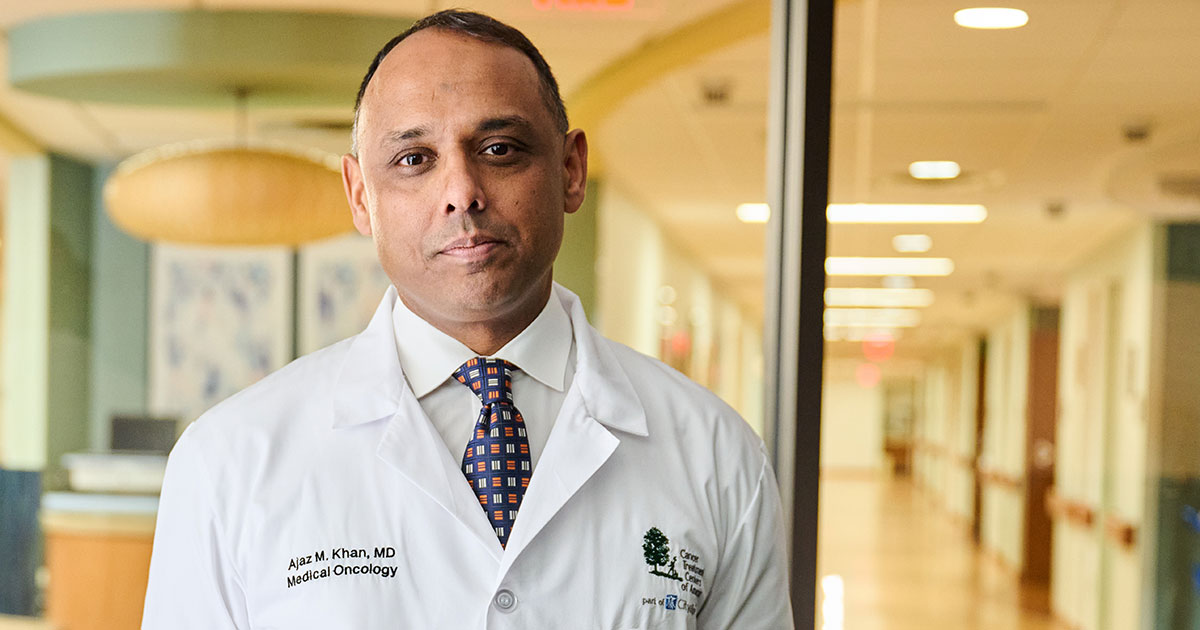
Throughout 15 years as a medical oncologist primarily caring for patients with breast cancer, I have found that fear of recurrence—or that cancer will return or progress—is nearly universal among patients undergoing treatment, no matter their cancer type.
My conversations with patients experiencing this fear and associated feelings are among the most challenging and complex.
Much of the survivorship literature has described this fear along a spectrum, ranging from mild to severe symptoms involving feelings of worry, distress or concern that a cancer may recur or persist despite treatment intended to be curative.
At the mild end, patients may experience occasional thoughts about cancer. But with moderate to severe symptoms, patients may suffer from the inability to control more frequent thoughts of recurrence, causing intrusive distress to daily life and feelings of hopelessness and despair.
Studies have revealed that up to 70 percent of patients with breast cancer are vulnerable to this type of fear, driven by a range of factors, including the predicted risk of recurrence, young age and psychosocial adjustment following the completion of treatment.
Women initially diagnosed with breast cancer before age 35 may experience significant fear about life expectancy as well as perceived risk of developing recurrent breast cancer throughout their lives. The patient’s underlying stress, anxiety and depression at diagnosis may lead to even higher levels of fear.
In this article, we’ll explore cancer recurrence and the fear of recurrence many patients experience. Topics include:
- What is recurrent cancer?
- Which cancers are more likely to recur?
- How common is breast cancer recurrence?
- How one patient managed her breast cancer recurrence fear
- Focusing on empowerment
If you believe you may be experiencing symptoms of breast cancer and want to schedule an appointment for diagnostic testing, or if you’re interested in a second opinion on your breast cancer diagnosis and treatment plan, call us or chat online with a member of our team.

What is recurrent cancer?
Cancer cells often develop mechanisms that allow them to avoid detection. They may turn dormant or burrow and hide in bone or distant organs. Even after treatments, such as surgery, chemotherapy or radiation therapy, or a combination of therapies, cancer cells may remain in numbers so small that they cannot be found or seen in a biopsy.
Not all cancer cells left behind after treatment survive the harsh conditions inside the human body. But those that do may start to grow and divide again, leading to a cancer recurrence.
The three different types of cancer recurrence are:
Local recurrence: The cancer has been found in the same place it was originally diagnosed.
Regional recurrence: The cancer has resurfaced in lymph nodes or tissue near the original site.
Distant recurrence: The cancer has been found in tissue in other parts of the body.
When cancer spreads beyond is primary source, it’s still named for the part of the body where it originated. So, if lung cancer spreads to the brain, it’s still considered lung cancer with brain metastasis, or metastatic lung cancer.
Some cancer patients may be at risk for developing a second, different cancer. Known as a second primary cancer, it’s different from a recurrent cancer.
Which cancers are more likely to recur?
Recurrence rates for cancer vary wildly depending in the type of subtype of cancer. For instance, recurrence rates for non-small cell lung cancer may vary from 30 to 55 percent, depending on its subtype and stage.
Cancers with some of the highest recurrence rates include those below.
Glioblastoma, the most common type of brain cancer: Nearly 100 percent
Epithelial ovarian cancer: 85 percent
Bladder cancer, after surgical removal of the bladder: 50 percent
Cancers with some of the lowest recurrence rates include those below.
Kidney cancer: 13 percent
Osteosarcoma: 12 percent
Hodgkin lymphoma: 13 percent
How common is breast cancer recurrence?
The overall recurrence rate for breast cancer is 30 percent. But, as with many other cancers, the rate varies depending on hormone receptor status or the subtype of the disease.
For instance, aggressive breast cancers, such as inflammatory breast cancer or triple-negative breast cancer are more like to recur. Hormone receptor positive breast cancers are less likely to recur.
According to the Susan G. Komen organization, most local recurrences develop within five years after treatment of an initial tumor. The risk of distant or metastasized recurrence remains the same whether you had a lumpectomy and radiation therapy or a mastectomy.
According to Susan G. Komen:
If you had a lumpectomy and radiation therapy, the risk of local recurrence within 10 years is up to 15 percent.
If you had a mastectomyand no cancer cells were found in the underarm lymph nodes, the risk of local recurrence within five years is about 6 percent.
If you had a mastectomy but no radiation therapy as part of your treatment and cancer was found in the lymph nodes, the risk of recurrence within five years rises to 23 percent.
Treatment with an aromatase inhibitor or hormone therapy medication are designed to help prevent recurrence of hormone-positive breast cancer.
How one patient managed her breast cancer recurrence fear
Let me share a story about one of my patients. She’s a 34-year-old mother of three young children, a practicing attorney and an avid athlete who was diagnosed with locally advanced triple-negative breast cancer.
During our first meeting, she described feelings of stress related to caring for her young children and her mother through treatment, coupled with uncertainty about managing family finances, completing treatment, achieving health and , in the end, surviving.
She also had trouble processing certain information we discussed, in part because she had lost a friend to cancer.
To help this patient manage her fear, we openly and thoroughly discussed her treatment, the possible side effects and chances of a cancer recurrence.
We also screened her level of distress through a validated questionnaire. Our care team provided close psychological monitoring via face-to-face interactions and telephone discussions to help alleviate anxiety and distress and to provide coping strategies aimed at maintaining lower levels of stress and addressing fears as they occur.
Upon completing treatment, this patient reported her fear was low. At her first survivorship visit, she expressed distress over developing chemotherapy-induced neuropathy in her feet that required long-term physical therapy with strength and balance rehabilitation. She returned to work but needed to adjust to walking slower and shifting her weight properly when going downstairs to prevent falls.
I reminded her that her fear was normal and experienced by many survivors. In fact, a high percentage of women with early-stage breast cancer have no evidence of disease after treatment and join the more than 3.9 million survivors who look forward to returning to a normal life.
Yet, for too many patients, side effects from cancer or its treatment create a new normal that may pose significant challenges requiring them to develop coping mechanisms to help them achieve greater balance and overcome physical, emotional and psycho-social challenges. Many patients experience anxiety-inducing side effects driven by reduced quality of life, inability to assimilate back to daily routines and a perpetual fear of cancer recurrence.
Focusing on empowerment
I believe in partnering with my patients throughout their cancer journeys. That means listening to their questions and ideas. It also entails creating a lineup of empowering strategies and actions for them to turn to during their survivorship.
During subsequent follow-ups with this patient, I emphasized addressing versus suppressing feelings of distress and anxiety by connecting with family, friends and her psychologist. We also identified possible fear- and anxiety-invoking triggers such as follow-up visits, imaging scans and the anniversary of her diagnosis.
Through her reading and research, she discovered antioxidants and herbal remedies she hoped would protect her from a cancer recurrence. I recognized her diligence but explained that, although supplements such as minerals, vitamins and antioxidants are vital components to our diet, no long-term studies have shown consistent or long-term benefits with any particular supplement in terms of preventing recurrence.
We discussed what a healthy lifestyle for people who have had breast cancer looks like:
- Be proactive and well-informed.
- Get regular cancer screenings, which may detect recurrence early.
- Maintain a healthy, balanced diet, which includes dietary fiber- and plant-based foods, and reduce processed meats and refined sugars to help lower cancer risk.
- Limit alcohol intake.
- Engage in stress-reducing activities like hobbies and exercise. A minimum of 150 minutes of exercise per week may help reduce the risk of recurrence.
With follow-ups visits or calls, conversations and interventions, this patient has been coping well and maintaining a better balance in her life and daily activities.
The fear of recurrence is real. It’s natural. There are ways to manage this fear so it doesn’t become overwhelming or debilitating. Physicians like me and a network of resources are here to help.
A version of this article was originally published in Curetoday.com.
